Class 10 Boards: Maths Questions That Will Definitely Be Asked
In the final stage of preparing for the Class 10 board exam, it helps to know what kind of questions to expect. It helps focus attention during revision, saves time and also shows you how well you are likely to do in terms of exam scores.
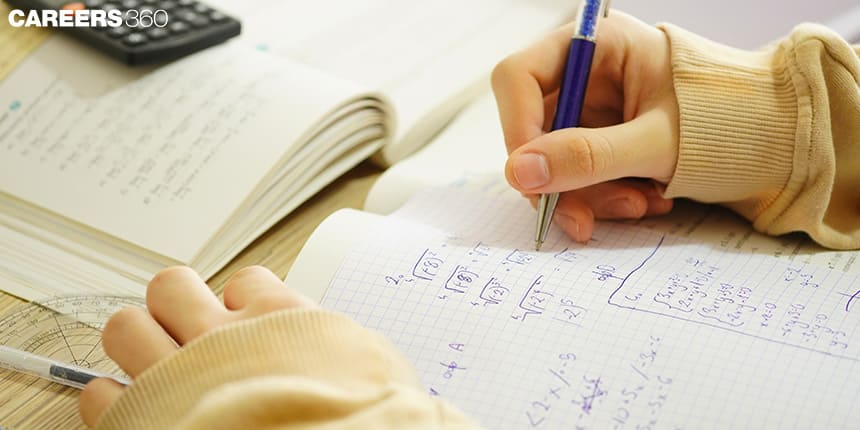
Based on previous years’ question papers, given here are 10 questions that are important from the board exam perspective and their solutions. These questions or ones like them are likely to be asked.
CBSE Class 10 Maths: Weightage
All sections of the CBSE Maths syllabus do not carry the same marks in the exam. The weight assigned to each varies and the unit-wise distribution is given below.
Unit | Weightage (In marks) |
Number Systems | 06 |
Algebra | 20 |
Coordinate Geometry | 06 |
Geometry | 15 |
Trigonometry | 12 |
Mensuration | 10 |
Statistics and Probability | 11 |
Total | 80 |
Internal Assessment | 20 |
Total | 100 |
The board exam paper carries 80 marks; the remaining 20 are assigned to internal assessment.
Algebra: 20 Marks
Algebra includes Polynomials, Pair of Linear Equations in two Variables, Quadratic Equations, and Arithmetic Progression. It carries the maximum marks of all the units and given below are the two most commonly-asked questions from this unit
Q-1: Find all the zeros of the polynomial 3x3+10x2-9x-4 if one of the zeros is 1.
Answer:
Given That: P(x) =3x3+10x2-9x-4 also one zero of p(x) is 1.
Find out: All zeros of polynomial p(x).
Since one zero of p(x) is 1, therefore, (x-1) is one factor of p(x)
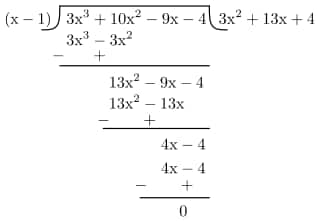
Thus p(x)=(x-1)(3x2+13x+4)
Now, let's find the zeros of (3x2+13x+4)
⇒ (3x2+13x+4)
⇒ (3x2+12x+x+4)
⇒ (3x(x+4)+1(x+4))
⇒ (3x+1)(x+4)
⇒ x=-1/3, x=-4
Therefore all zeros of polynomial P(x) =3x3+10x2-9x-4 are 1, -1/3, -4
Also read | Physics Class 10 Board Exam - 10 Most Probable Questions
Q-2: Solve the pair of equations:
2x+3y=11 and 5x-4y=-7 Also Find the value of 5x-3y
Answer:
Given that: A pair of equations i.e 2x+3y=11 and 5x-4y=-7
Find: solve these equations and find out the value of 5x-3y
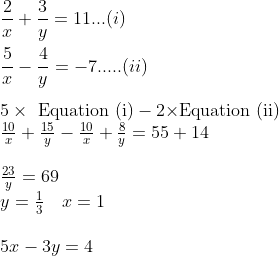
Geometry: 15 Marks
This unit includes Triangles, Circles, and Constructions. These are the two most important questions from this unit.
Q-3: If in the following image PQ ∥ BC and PR ∥ CD then prove that QB/AQ=DR/AR
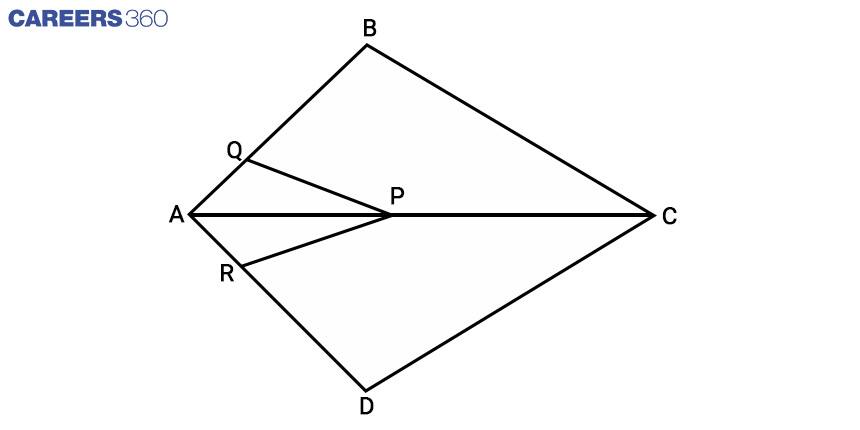
Answer:
Given that: PQ ∥ BC and PR ∥ CD
We want to prove that: QB/AQ=DR/AR
We know that if a line is drawn parallel to one side of a triangle and it intersects the other two sides in distinct points, then the other two sides are divided in the same ratio.
Therefore
AQ/QB=AP/PC.........(1)
AR/DR=AP/PC.........(2)
Using Equation (1) and equation (2)
AQ/QB=AR/DR
It can be rewritten as
QB/AQ=DR/AR
Hence Proved.
Q-4: If a circle touches the side BC of a triangle ABC at P and extended sides AB and AC at Q and R, respectively, prove that AQ = 1/2(BC+CA+AB).
Answer:
Given that: a circle touches side BC of △ABC at point P and points Q, and R are on extended side AB and BC.
We Want to prove AQ = 1/2(BC+CA+AB)
According to the given information we can create a diagram as given below.
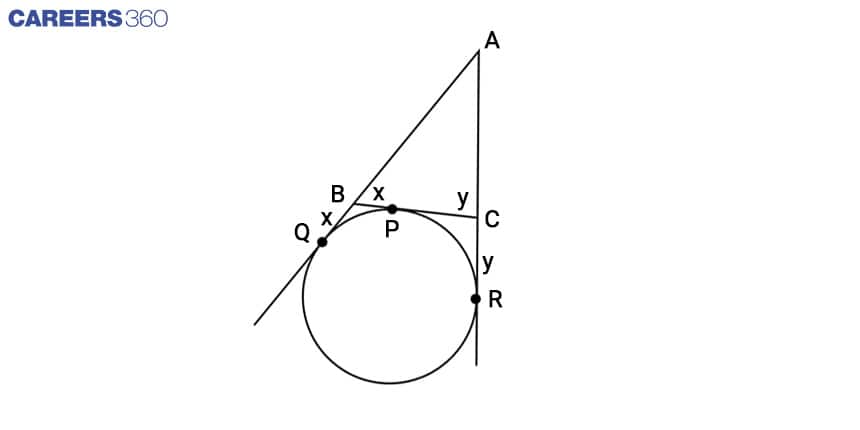
Let's assume BP = x
We know that tangents drawn on a circle from an external point are equal in length.
Therefore BQ=x
In a similar way if we assume CP = y then BR =y
AB+BC+CA=(AQ-x)+(x+y)+(AR-y)
And using the above concept we can say that AQ=AR
Therefore AB+BC+CA = 2AQ
⇒ AQ=1/2(AB+BC+CA)
Hence proved.
Trigonometry:12 Marks
This unit includes Trigonometry and its applications. The questions given below are common.
Q-5: Prove that :
![]()
Answer:
We want to prove:
√{(1+sinA)/(1-sinA)}=secA+tanA
We can start from LHS and prove it equals RHS.
LHS=√{(1+sinA)/(1-sinA)}
Multiply denominator and numerator with √(1+sinA)
=√[{(1+sinA)/(1-sinA)}.{(1+sinA)/(1+sinA)}]
Here we can apply this concept
(a+b)(a-b)=a2-b2
= √{(1+sinA)2/1-sin2A}
We know that 1-sin2A=cos2A
= √{(1+sinA)2/cos2A}
= (1+sinA)/cosA=1/cosA+sinA/cosA
= secA+tanA = RHS
Hence Proved.
Also Read | Class 10 Science: Here’s Why You Should Pay Attention To Experiments
Q-6: If the angle of elevation of a cloud from a point 10 metres above a lake is 30° and the angle of depression of its reflection in the lake is 60°, find the height of the cloud from the surface of the lake.
Answer:
Given that: angle of elevation = 30°, angle of depression = 60° and lake depth = 10m
Find out: Height of the cloud from the surface of the lake
According to the given information we can draw the figure given below.
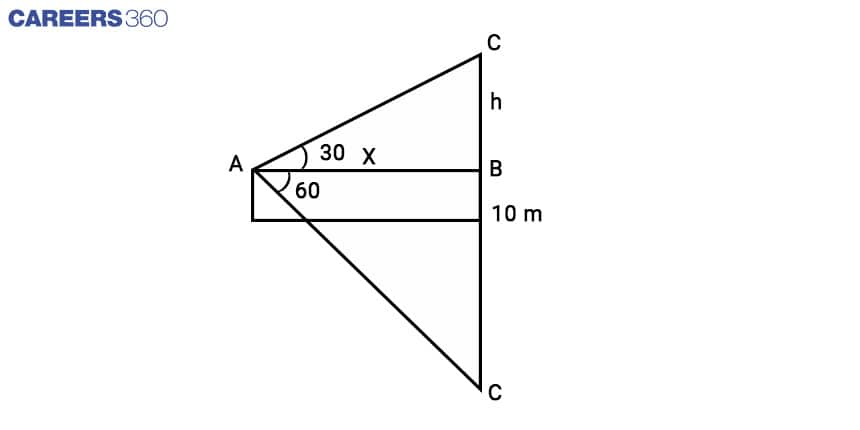
BC=h and BC'=h+10
In the triangle, ABC we can say tan30 = h/x
We know that tan30 = 1/√3
x=h√3...........(1)
Using the same concepts in triangle ABC'
tan60 = (h+10)/x
We know that tan60 = √3
Therefore x=(h+10)/√3...........(2)
Using equations (1) and (2)
h√3=(h+10)/√3
3h = h+10
From here h=5m
Hence the height of the cloud from the surface of the lake = 5 + 10 + 5 = 20m
Statistics And Probability: 11 Marks
These are the questions asked most often from this section.
Q-7: There are 100 cards in a bag on which numbers from 1 to 100 are written. A card is taken out of the bag at random. Find the probability that the number on the selected card
(1) is divisible by 9 and is a perfect square
(2) is a prime number greater than 80
Answer:
Given that: 100 cards on which numbers from 1 to 100 are written
Find: the probability that the number on the card selected
(1) is divisible by 9 and is a perfect square
(2) is a prime number greater than 80
We can observe that
1) Three numbers {9,36,81} are divisible by 9 and a perfect square.
n(E1) = 3
Therefore probability of a number which is divisible by 9 and a perfect square
P1=n(E1)/n(T)=3/100
2) Three numbers {83, 89, 97} are greater than 80 and prime numbers.
n(E2) = 3
The probability of a number which is greater than 80 and a prime number
P2=n(E2)/n(T)=3/100
Mensuration: 10 Marks
This unit includes Areas Related to Circles, and Surface Areas and Volumes.
Q-8: A solid is in the shape of a hemisphere surmounted by a cone. If the radius of the hemisphere and base radius of the cone is 7 cm and the height of the cone is 3.5 cm, find the volume of the solid. (Take = 22/7)
Answer:
Given that radius of a hemisphere and the base radius of a cone = R = 7cm
Height of cone h = 3.5 cm
Find out: the volume of solid
According to the given information, we can draw the solid as given below.
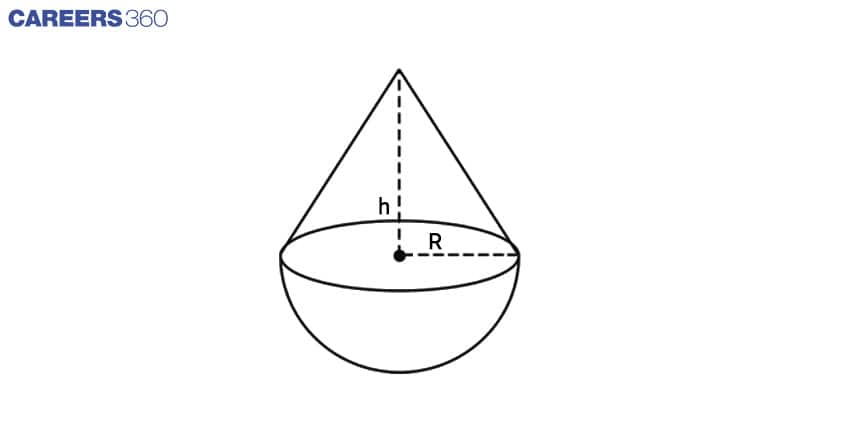
We know that volume of a hemisphere is given by
(2/3)πR3
and the volume of a solid cone is given by
(1/3)πR2h
Therefore the volume of a given solid is given as
(2/3)πR3+(1/3)πR2h
= (1/3)πR2(2R+h)
= (1/3)(22/7)(7)2(14+3.5)
= (1/3)(22/7)(7)2(17.5)=898.33cm3
Hence the volume of a solid cone is 898.33cm3
Also Read | Quick And Easy Understanding Of Trigonometry For Class 10
Coordinate Geometry: 6 Marks
This section carries just six marks and this is the type of question to expect..
Q-9: Find the area of triangle PQR formed by the points P(-5,7), Q(-4, -5), and R(4,5).
Answer:
Given that: the coordinates of a triangle
Find out: the area of a triangle
We know that the area of a triangle is given by the following formula when the coordinates of the vertices of a triangle are given.
(x1,y1), (x2,y2), (x3,y3)
Area of Triangle = 1/2√[x1(y2-y3)+x2(y3-y1)+x3(y1-y2)]
Here vertices are P(-5,7), Q(-4, -5) and R(4,5)
Therefore
Area of triangle PQR = 1/2√[-5(-5-5)+(-4)(5-7)+4(7-(-5))]
= 1/2√[-5(-10)+(-4)(-2)+4(12)]
= 1/2√[50+8+48] = 53 sq. unit
Hence the area of triangle PQR will be 53 sq. units
Number System: 6 Marks
This includes one chapter Real Number that contains concepts like Euclid’s division lemma, Euclid’s division algorithm, The Fundamental Theorem of Arithmetic, irrational numbers and their proof, and others.
Q-10:
Use Euclid Division Lemma to show that the square of any positive integer is either of the forms 3q or 3q+1 for some integer q.
Answer:
Given that: a square of a positive integer.
We want to show that it is of the form of 3q or 3q+1
If a and b are two positive integers, then, by Euclid division lemma
a = bm + r, 0 ≤r ≤b Let b = 3
Therefore, r = 0, 1, 2
Therefore, a = 3m, a = 3m + 1, or a = 3m + 2
If a = 3m:
a2 = 9m2=3(3m2)=3q here q=3m2
If a = 3m + 1:
a2=(3m+1)2=9m2+6m+1 = 3(3m2+2m)+1 = 3q+1
Here q=3m2+2m
If a = 3m + 2:
a2=(3m+2)2=9m2+12m+4 = 3(3m2+4m+1)+1 = 3q+1
Here q=(3m2+4m+1)
Therefore, the square of any positive integer is either of the form 3q or 3q + 1 for some integer q.
Hence proved.
Applications for Admissions are open.
As per latest syllabus. Physics formulas, equations, & laws of class 11 & 12th chapters
JEE Main Important Chemistry formulas
Get nowAs per latest syllabus. Chemistry formulas, equations, & laws of class 11 & 12th chapters
JEE Main high scoring chapters and topics
Get nowAs per latest 2024 syllabus. Study 40% syllabus and score upto 100% marks in JEE
JEE Main Important Mathematics Formulas
Get nowAs per latest syllabus. Maths formulas, equations, & theorems of class 11 & 12th chapters